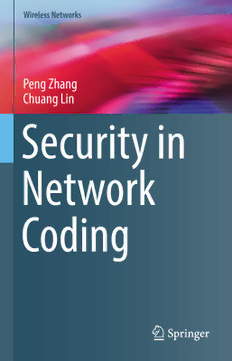Table Of ContentWireless Networks
Peng Zhang
Chuang Lin
Security in
Network
Coding
Wireless Networks
SeriesEditor
XueminShermanShen
Moreinformationaboutthisseriesathttp://www.springer.com/series/14180
Peng Zhang • Chuang Lin
Security in Network Coding
123
PengZhang ChuangLin
DepartmentofComputerScience DepartmentofComputerScience
andTechnology TsinghuaUniversity
Xi’anJiaotongUniversity Beijing,China
Xi’an,China
ISSN2366-1186 ISSN2366-1445 (electronic)
WirelessNetworks
ISBN978-3-319-31082-4 ISBN978-3-319-31083-1 (eBook)
DOI10.1007/978-3-319-31083-1
LibraryofCongressControlNumber:2016935869
©SpringerInternationalPublishingSwitzerland2016
Thisworkissubjecttocopyright.AllrightsarereservedbythePublisher,whetherthewholeorpartof
thematerialisconcerned,specificallytherightsoftranslation,reprinting,reuseofillustrations,recitation,
broadcasting,reproductiononmicrofilmsorinanyotherphysicalway,andtransmissionorinformation
storageandretrieval,electronicadaptation,computersoftware,orbysimilarordissimilarmethodology
nowknownorhereafterdeveloped.
Theuseofgeneraldescriptivenames,registerednames,trademarks,servicemarks,etc.inthispublication
doesnotimply,evenintheabsenceofaspecificstatement,thatsuchnamesareexemptfromtherelevant
protectivelawsandregulationsandthereforefreeforgeneraluse.
Thepublisher,theauthorsandtheeditorsaresafetoassumethattheadviceandinformationinthisbook
arebelievedtobetrueandaccurateatthedateofpublication.Neitherthepublishernortheauthorsor
theeditorsgiveawarranty,expressorimplied,withrespecttothematerialcontainedhereinorforany
errorsoromissionsthatmayhavebeenmade.
Printedonacid-freepaper
ThisSpringerimprintispublishedbySpringerNature
TheregisteredcompanyisSpringerInternationalPublishingAGSwitzerland
Preface
NetworkcodingisanewtransmissionparadigmproposedbyAhlswedeetal.around
theyear2000.Ithasbeenrecognizedasanotherbreakthroughininformationtheory
afterShannon.Thekeydifferenceofnetworkcodingfromtraditionaltransmission
paradigmsisthatin-networknodescanperformcodingonpackets,insteadofsimple
store-and-forward. Benefits of network coding include higher data throughput,
lower energy consumption, reduced bandwidth cost, etc. Due to these benefits,
networkcodinghasbeenappliedtovariouskindsofnetworks,e.g.,wirelessmesh
networks,contentdistributionnetworks,distributedstoragenetworks,etc.
However, network coding also introduces new security and privacy challenges
at the same time. The most serious problem is that it makes data transmission
more vulnerable to pollution attacks. A single illegal packet can end up polluting
a bunch of good ones through intermediate coding, and causing severe bandwidth
waste.Besidesdataintegrity,dataconfidentialityanduserprivacyalsobecomequite
differentinthenewcontextofnetworkcoding.Ontheonehand,wecanleveragethe
intrinsicsecrecypropertyofnetworkcodingtoprovidealightweightconfidentiality.
On the other hand, we should redesign privacy-preserving mechanisms (e.g.,
anonymousrouting)tomakethemcompatiblewithnetworkcoding.
ThisbookwillfirstgiveabriefreviewofnetworkcodinginChap.1,including
itsbenefits,applications,andsecurityproblems.Then,Chap.2willgiveadetailed
review of security issues in network coding, highlighting how the security issues
differ from those in traditional settings. In Chaps.3–5, we will introduce three
researchworkstoaddressthesesecurityissues.Thefirstwork(Chap.3)proposesa
newmethodtodefeatpollutionattacksinnetworkcoding.Basedonthismethod,a
set of security mechanisms including a private key-based signature, a symmetric
key-based MAC, and a hybrid key-based approach are presented and evaluated.
The second work (Chap.4) focuses on data confidentiality in network coding
and presents a new encryption scheme named P-Coding. P-Coding recognizes
the intrinsic secrecy property of random linear network coding and leverages it
to offer a rather lightweight encryption which is very appealing in mobile ad
hoc networks (MANETs). The third work (Chap.5) identifies the problem that
existing anonymous routing protocols (e.g., Tor) conflict with wireless network
v
vi Preface
coding.Thisworkintroducescooperationamongwirelessnodesinordertoresolve
such conflict, so that wireless user privacy and network coding benefits can be
simultaneously maintained. Finally, in Chap.6, we will conclude this book and
discusssomefuturedirectionsfortheresearch“securityinnetworkcoding.”
Xi’an,China PengZhang
Beijing,China ChuangLin
Acknowledgments
TheauthorswouldliketothankXuemin(Sherman)Shen,YixinJiang,PatrickP.C.
Lee,JohnC.S.Lui,HongyiYao,ChaoZhang,andYanfeiFanfortheircontribution
tothetechnicalpartsofthisbook.
vii
Contents
1 Introduction ................................................................... 1
1.1 ABriefReviewofNetworkCoding..................................... 1
1.2 BenefitsofNetworkCoding............................................. 2
1.3 ApplicationsofNetworkCoding........................................ 3
1.4 InsecurityofNetworkCoding........................................... 4
1.5 BookOrganization....................................................... 5
References...................................................................... 5
2 SecurityThreatsinNetworkCoding ....................................... 9
2.1 PollutionAttack.......................................................... 9
2.1.1 Information-TheoreticSchemes................................. 9
2.1.2 Cryptography-BasedSchemes .................................. 10
2.2 EavesdroppingAttack.................................................... 12
2.2.1 ShannonSecurity ................................................ 12
2.2.2 WeakSecurity.................................................... 13
2.2.3 ComputationalSecurity ......................................... 14
2.3 EntropyAttack........................................................... 15
2.4 PrivacyLeakage.......................................................... 16
References...................................................................... 17
3 SubspaceAuthenticationforRandomLinearNetworkCoding......... 21
3.1 Introduction .............................................................. 21
3.2 ProblemStatement....................................................... 23
3.2.1 NetworkModel .................................................. 23
3.2.2 AdversaryModel ................................................ 24
3.3 HomomorphicSubspaceAuthentication................................ 24
3.3.1 BasicIdeaOverview............................................. 24
3.3.2 HomomorphicSubspaceSignature ............................. 26
3.3.3 BatchedVerificationforHSS ................................... 27
3.3.4 HomomorphicSubspaceMAC.................................. 28
3.3.5 KeyDistributionforHSM....................................... 31
ix

